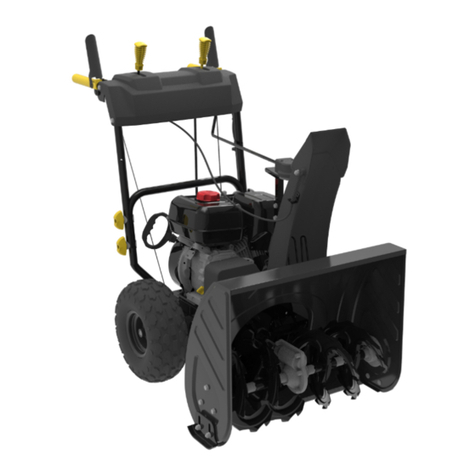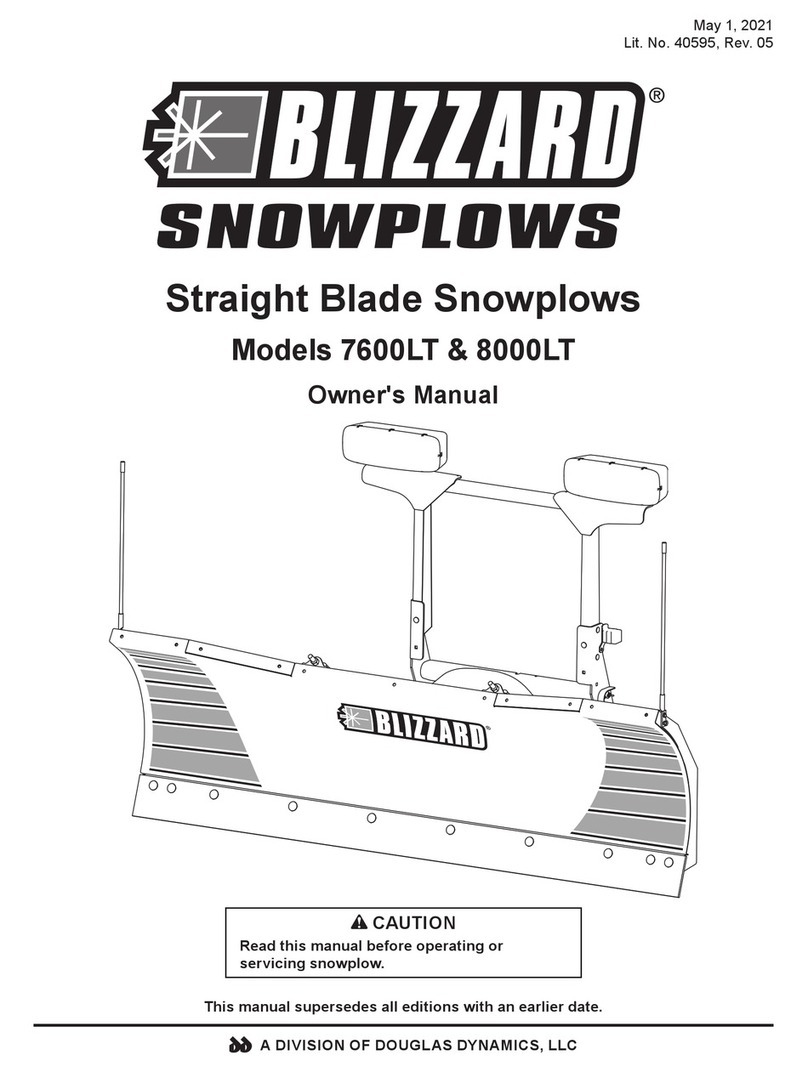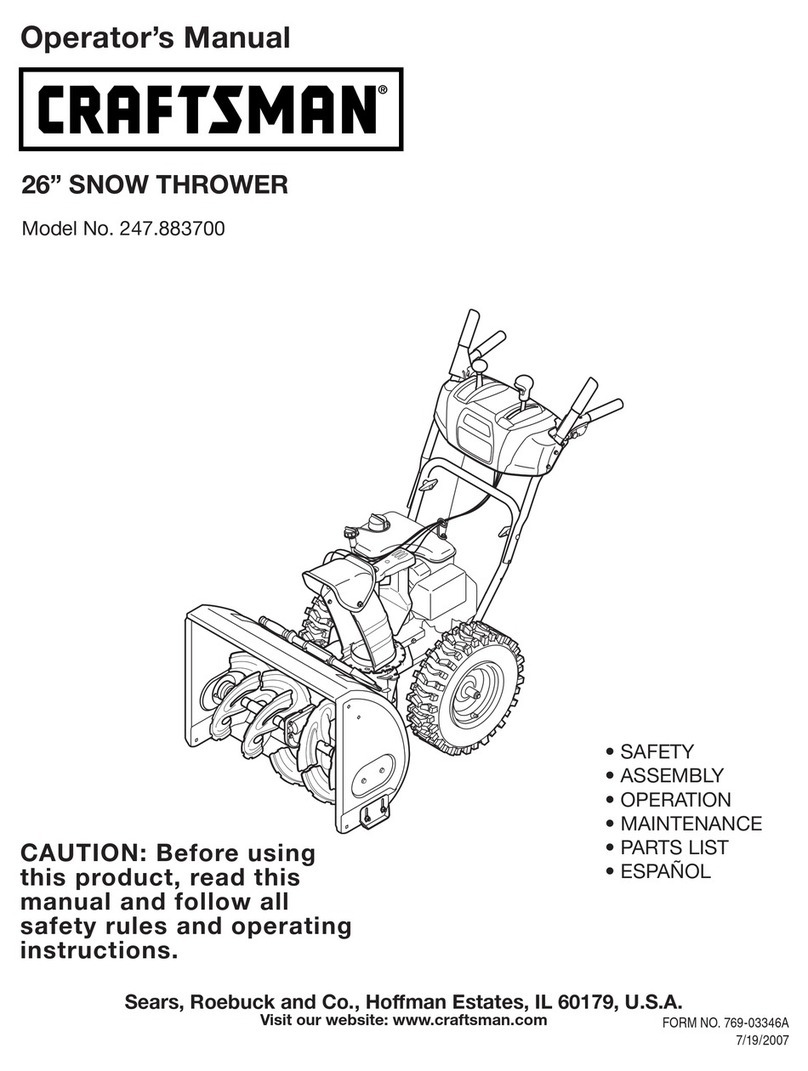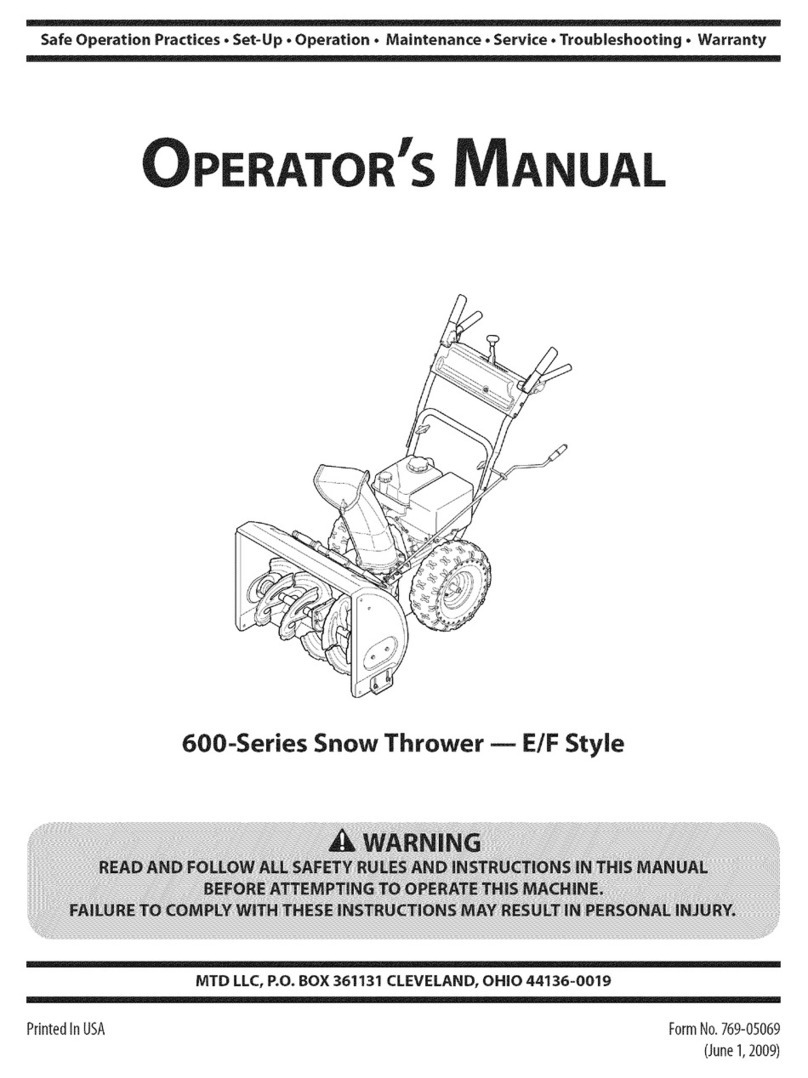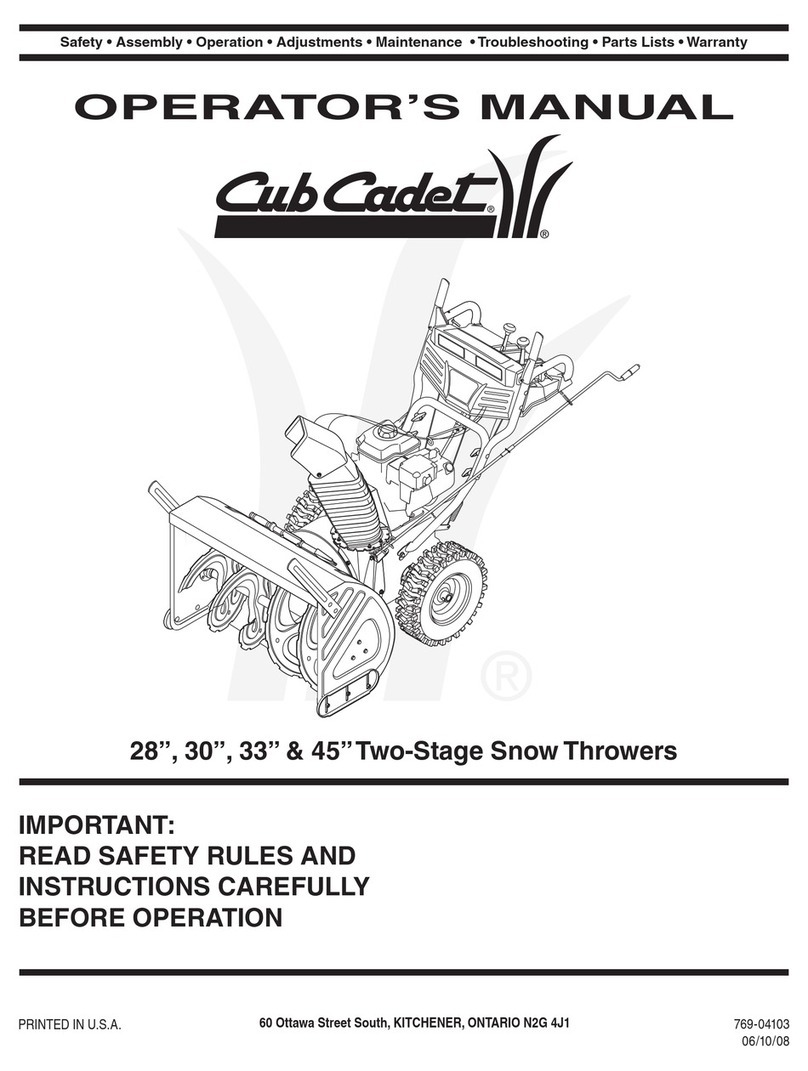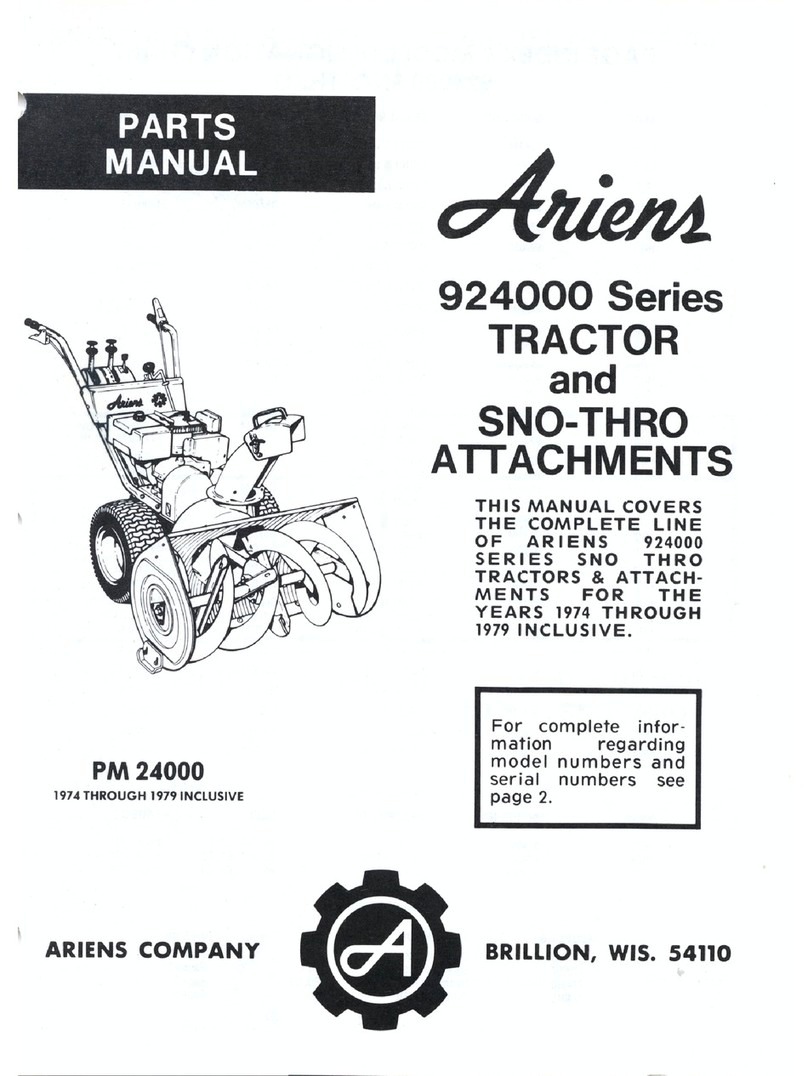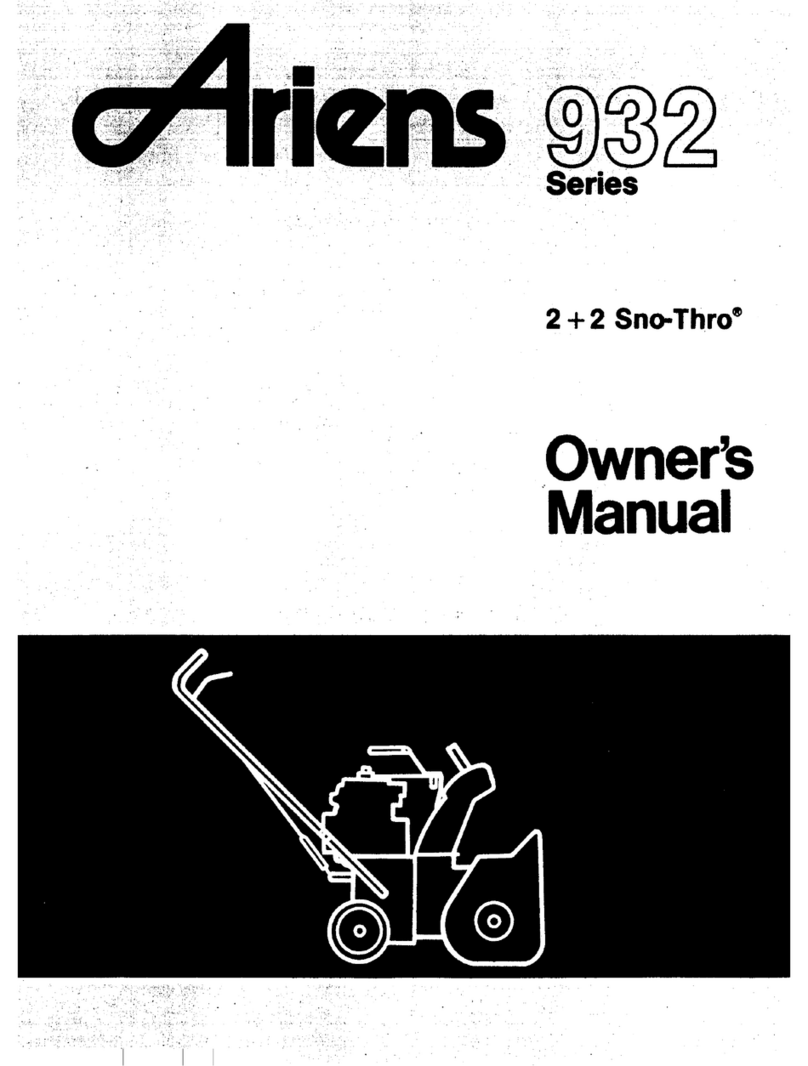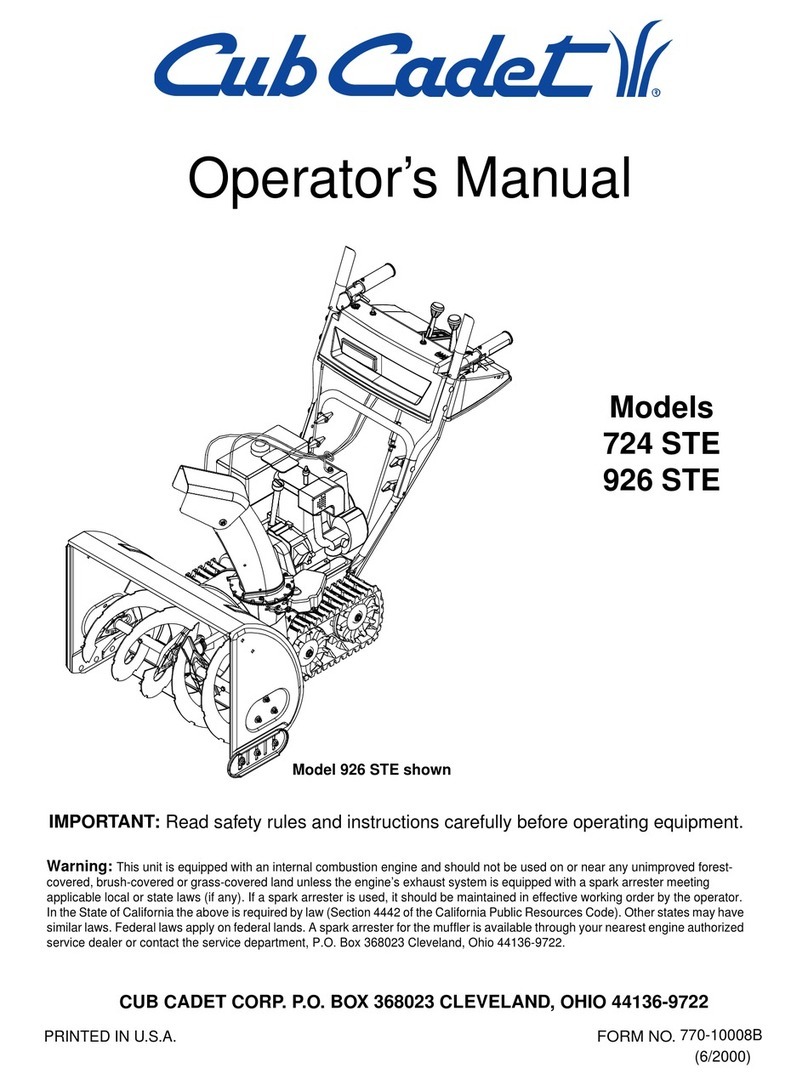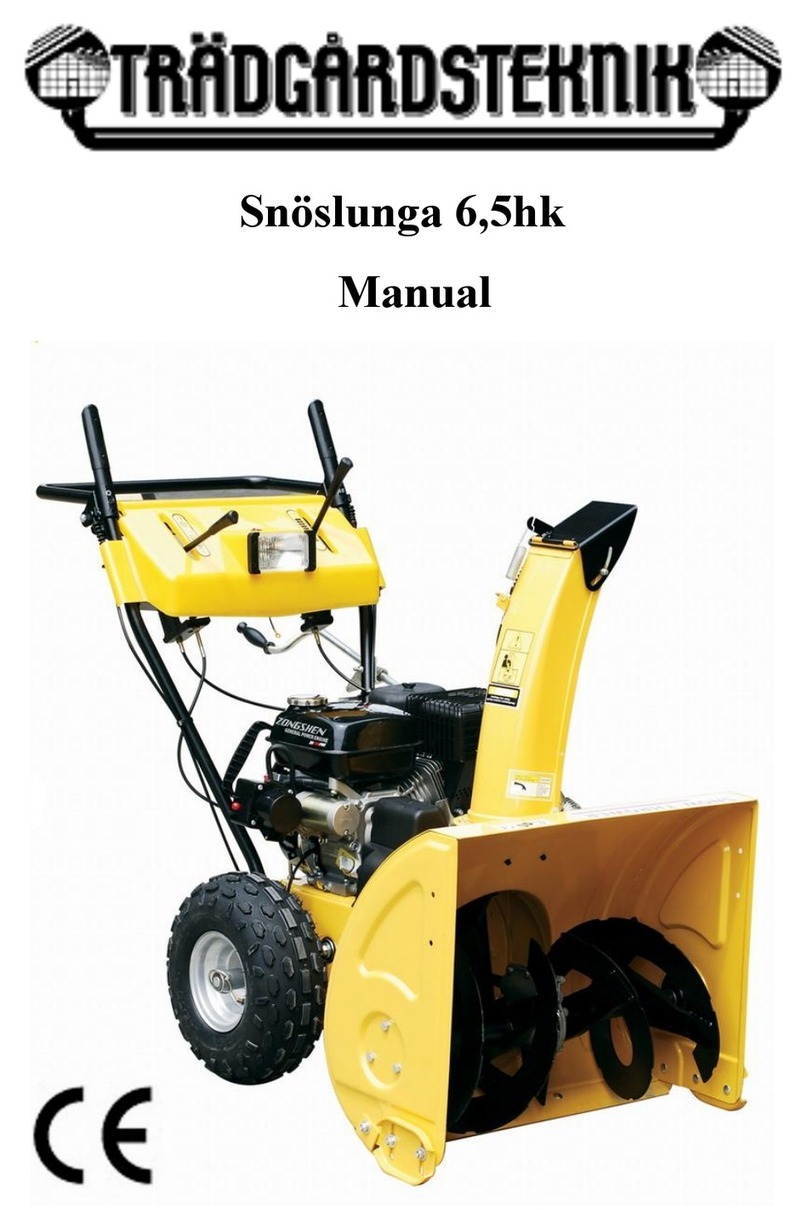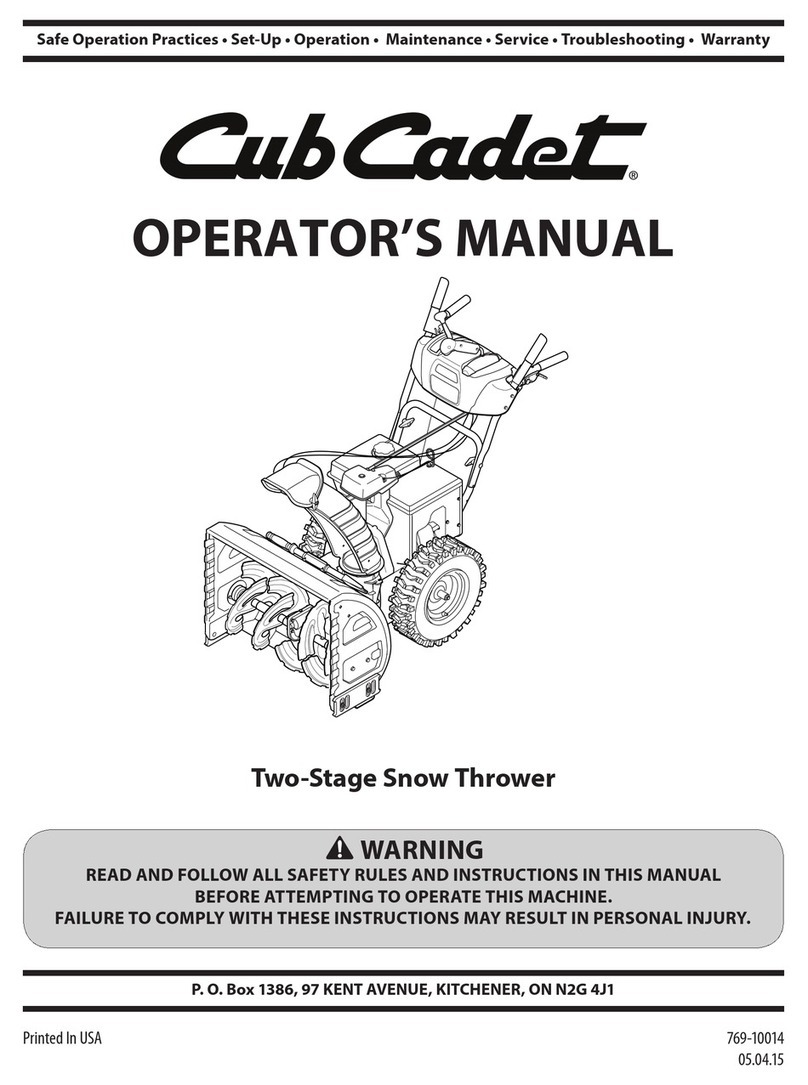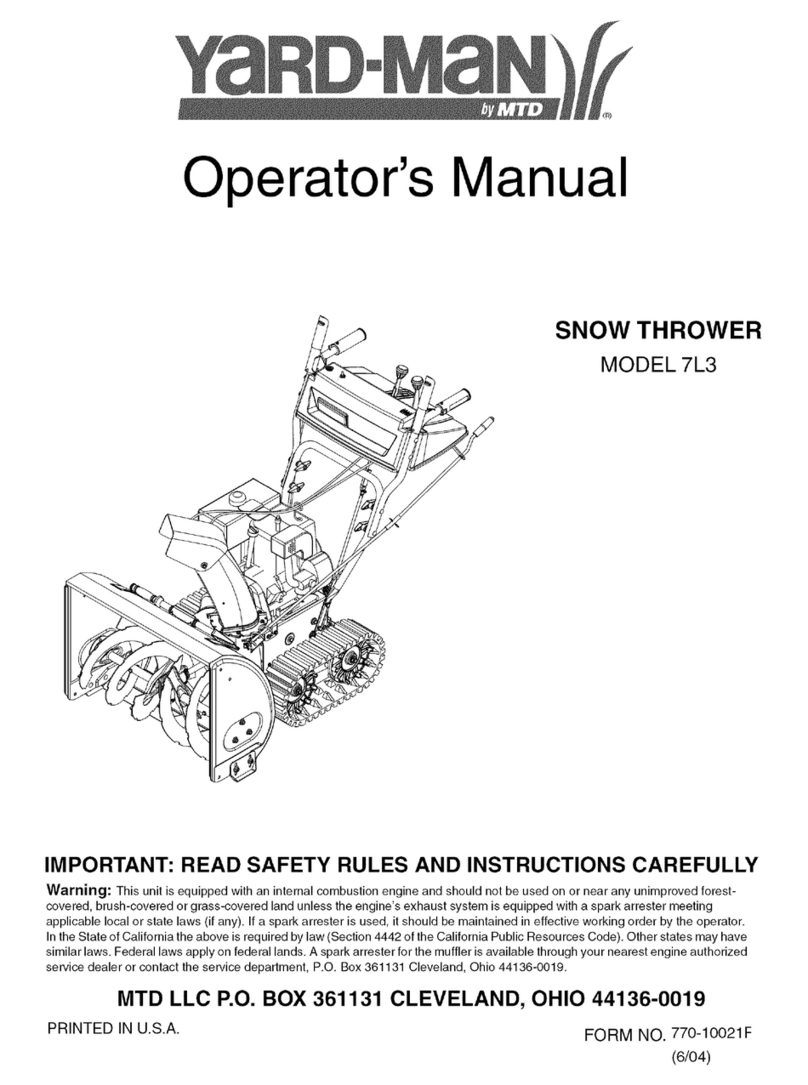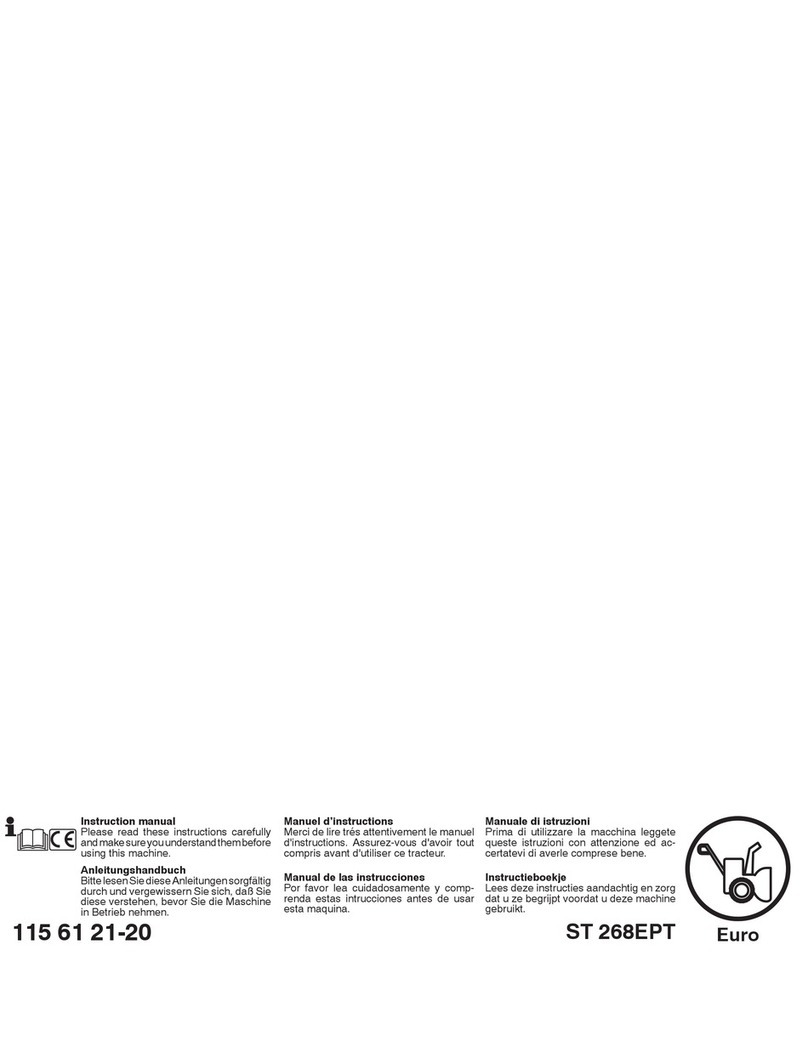FXA 502296335 User manual

1
Gasoline snow thrower 66/71 cm
502296335/502296336
Instruction manual (Original instructions) GB 3-35
Käyttöohje (Alkuperäisten ohjeiden käännös) FI 36-66
Bruksanvisning (Översättning av originalinstruktionerna) SE 67-97
Bruksanvisning (Oversettelse av de opprinnelige instruksjonene) NO 98-128
Kasutusjuhend (originaaljuhend) EE 129-159

2
IMPORTANT: Read and understand this manual before assembling or operating this
Gasoline Snow thrower. Improper use of Snow thrower can cause severe injury. Keep this
manual for future reference.
TÄRKEÄÄ! Lue ja ymmärrä tämä käyttöohje ennen bensiinikäyttöisen lumilingon
kokoonpanoa tai käyttöä. Lumilingon väärä käyttö voi aiheuttaa vakavan loukkaantumisen.
Säilytä tämä ohje tulevaa tarvetta varten.
VIKTIGT: Läs och förstå denna bruksanvisning innan montering eller användning av
denna bensindrivna snöslunga. Felaktig användning av snöslungan kan orsaka allvarliga
personskador. Förvara dessa instruktioner för framtida referens.
VIKTIG: Les og forstå denne håndboken før du monterer eller bruker denne bensindrevne
snøfreseren. Feil bruk av snøfreseren kan forårsake alvorlig skade. Ta vare på denne håndboken for
fremtidig bruk
TÄHTIS! Enne bensiinimootoriga lumepuhuri kokkupanekut või kasutuselevõttu lugege juhend
hoolikalt läbi ja tehke see endale selgeks. Lumepuhuri väär kasutamine võib tekitada raskeid
vigastusi. Hoidke juhend edaspidiseks kasutamiseks alles.

3
Gasoline snow thrower 66/71CM
502296335/DB7103B-26L
502296336/DB7103B-28L
Instruction manual
TABLE OF CONTENTS
I- Important Safe Operation Practices
II-Knowing Your Snow Thrower
III-Assembling Your Snow Thrower
IV-Snow Thrower Prepration
V- Operating Your Snow Thrower
VI-Maintaining You Snow Thrower
VII-Storge Your Snow Thrower
VIII-Troubleshooting
IX-EU Declaration of Conformity

4
I- IMPORTANT SAFE OPERATION PRACTICES
This symbolpoints out important safetyinstructions which, if notfollowed, could endanger the personal
safety and or property of yourself and others. Read and follow all instructions in this manual before
attempting to operate this machine. Failure tocomply with these instructions mayresult in personal injury.
WARNING! This machine was built to be operated according to the safe operation practices in this manual.
As with any type of power equipment, carelessness or error on the part of the operator can result in serious
injury. This machine is capable of amputating fingers, hands, toes and feet and throwing foreign objects.
Failure to observe the following safety instructions could result inserious injuryor death.
Safety Symbol
This page depicts and describes safety symbols that may appear on this product. Read, understand and
follow all instructions on the machine before attempting to assemble and operate.
READ THE OPERATOR'S MANUAL(S)
Read, understand and follow allinstructions in themanual(s) before attempting toassemble and operate.
Thefollowing warning symbols are to remind you of the safety precautions you should take when operatingthe
snowthrower.
Use ear protection
Use eye protection
Keep childen and pets a safe distance away from the machine.
WARNING-ROTATING AUGER
Do not put hands or feet near rotating parts, in the auger/impeller housing or chute assembly, Contact with the
rotating parts can amputate hands and feet.
WARNING-ROTATING BLADES
Keep hands out of inlet and discharge openings while machine is running ,There are rotating
blades inside
WEARING-THROWN OBJECTS
This machine may pick up and throw and objects which can cause serious personal injury
Do not touch any rotating part before machine stops.
WARNING- ROTATING BLADES
Keep hands out of inlet and discharge openings while machine is running ,There are rotating
blades inside
Waste electrical products should notbe disposed ofwith household waste. Please recycle where facilities exist.
Check with your local authority or retailer for recycling advice
WARNING-GASOLINE IS FLAMMABLE
Allow the engine to cool at least two minutes before refueling.
WARNING-CARBON MONOXIDE
Never run an engine indoors or in a poorly ventilated area. Engine exhaust contains carbon monoxide, an
odorless and deadly gas.
WARNING-ELECTRICAL SHOCK ( for engine with electric starter) Do not use the engine's electric starter in
the rain.

5
TRAINING
Read, understand, and follow all instructions on the machine and in the manual(s) before
attempting to assemble and operate. Keep this manual in a safe place for future and regular
reference.
•
Be familiar with all controls and their proper operation. Know how to stop the machine and
disengage them quickly.
•
.Never allow children under 18 years old to operate this machine. Children 18 years old and
over should read and understand the operation instruction and safety rules in this manual
and should be trained and supervised by a parent.
•
Never allow “non-trained” adult personnel to operate this machine without proper instruction.
•
Thrown objects can cause serious personal injury. Plan and map out your snow-throwing
pattern to avoid discharge of material toward roads, bystanders and the like.
•
Keep bystanders, pets and children at least 75 feet from the machine while it is in
operation. Stop machine if anyone enters the area.
•
Exercise caution to avoid slipping or falling, especially when operating in reverse.
PREPARATION
Thoroughly inspect the area where the equipment is to be used. Remove all doormats,
newspapers, sleds, boards, wires, branches and other foreign objects, which could be
hazardous and damage the auger system.
•
Always wear safety glasses or eye shields during operation and while performing an
adjustment or repair to protect your eyes, as thrown objects can ricochet and cause
serious injury to the eyes.
•
Do not operate without wearing adequate, winter outer garments. Do not wear jewelry, long
scarves or other loose clothing, which could become entangled in moving parts, and wear
footwear that will improve footing on slippery surfaces.
•
Use a grounded “three-wire” extension cord and receptacle for all machines with
electric start engines.
•
Adjust skid shoe and/or housing height to clear gravel or crushed rock surfaces.
•
Disengage all control levers before starting the engine.
•
Never attempt to make any adjustments while engine is running, except where
specifically recommended in the instruction manual.
•
Let engine and machine adjust to outdoor temperature before starting to clear snow.

6
PERSONAL SAFETY
•
Engine exhaust, and certain vehicle components contain or emit chemicals known to
cause cancer, birth defects or other reproductive harm.
•
Read, understand and follow all instructions on your snow thrower unit and in this instruction
manual before attempting to assemble and operate your machine.
•
Keep this instruction manual in a safe place for future and regular reference.
•
Stay alert, watch what you are doing and use common sense when operating your snow
thrower unit.
•
Do not use your snow thrower unit while you are tired or under the influence of drugs,
alcohol, medication. A moment of inattention while operating the snow thrower may result
in severe bodily injury.
•
NEVER LEAVE YOUR RUNNING SNOW THROWER UNATTENDED. Stop the engine!
•
Do not leave your snow thrower unit until it has come to a complete stop.
•
When stepping backwards, be cautious about any obstacles beneath your feet or behind
you avoid falling.
SERVICE
•
Stop the engine before making any adjustments. Check for misalignment, breakage or
binding of moving parts, and any other conditions that may affect operation.
•
If damaged, have the snow thrower unit serviced by an authorized service center using only
specified, manufactured replacement parts. This will ensure that the safety of the snow
thrower unit is maintained.
SAFE HANDLING OF GASOLINE
To avoid personal injury or property damage use extreme care in handling gasoline. Gasoline is
extremely flammable and the vapors are explosive. Serious personal injury can occur when
gasoline is spilled on yourself or your clothes which can ignite, therefore wash your skin and
change clothes immediately.
•
Use only an approved gasoline container.
•
Extinguish all cigarettes, cigars, pipes and other sources of ignition.
•
Never fuel snow thrower unit’s engine indoors.
•
Never remove gas cap or add fuel while the engine is hot or running.
•
Allow engine to cool at least two minutes before refueling.

10
•
Never over fill fuel tank.
•
Replace gasoline cap and tighten securely.
•
If gasoline is spilled, wipe it off the engine and equipment. Move machine to another area.
Wait 5 minutes before starting the engine.
•
Never store the machine or fuel container inside where there is an open flame, spark or pilot
light (e.g. furnace, water heats, space heater, clothes dryer etc.).
•
Allow machine to cool at least 5 minutes before storing.
•
Never fill containers inside a vehicle or on a truck or trailer bed with a plastic liner. Always
place containers on the ground away from your vehicle before filling.
•
If possible, remove gas-powered equipment from the truck or trailer and refuel it on the
ground.
•
If this is not possible, then refuel such equipment on a trailer with a portable container,
rather than from a gasoline dispenser nozzle.
•
Keep the nozzle in contact with the rim of the fuel tank or container opening at all times until
fueling is complete. Do not use a nozzle lock open device.
OPERATION
•
Do not put hands or feet near rotating parts, in the auger impeller housing or chute
assembly. Contact with the rotating parts can amputate hands and feet.
•
The auger (impeller) control lever is a safety device. Never bypass its operation. Doing so
makes the machine unsafe and may cause personal injury.
•
The control levers must operate easily in both directions and automatically return to the
disengaged (vertical) position when released.
•
Never operate with a missing or damaged chute assembly. Keep all safety devices in
place and working.
•
Never run an engine indoors or in a poorly ventilated area. Engine exhaust contains carbon
monoxide, an odorless and deadly gas.
•
Do not operate machine while under the influence of alcohol or drugs.
•
Muffler and engine become hot and can cause burning. Do not touch. Keep children away.
•
Exercise extreme caution when operating on or crossing gravel surfaces. Stay alert for
hidden hazards or traffic.

11
•
Exercise caution when changing direction and while operating on slopes.
•
Plan your snow-throwing pattern to avoid snow discharge towards windows, walls, cars
etc., thus avoiding possible property damage or personal injury caused by a ricocheting
debris.
•
Never direct discharge at children, bystanders and pets or allow anyone in front of the
machine.
•
Do not overload machine capacity by attempting to clear snow at too fast of a rate….
Remember! Slow and steady operation is best to avoid clogs of snow being
impelled too rapidly.
•
Never operate this machine without good visibility or light. Always be sure of your footing
and keep a firm hold on the handles. Walk, never run.
•
Disengage power to the auger system (auger/impeller) by releasing the auger control
(lever) when transporting or not in use.
•
Never operate machine at high transport speeds on slippery surfaces. Look down and
behind and use care when backing up.
•
If the machine should start to vibrate abnormally, stop the engine, disconnect the spark plug
wire and ground it against the engine. Inspect thoroughly for damage. Repair any damage
before starting and operating.
•
Disengage all (drive and auger) control levers and stop engine before you leave the
operation position (behind the handles).
•
Wait until the auger /impeller comes to a complete stop before unclogging the chute
assembly, making any adjustments or inspections.
•
Never put your hand in the discharge or collector openings. Always use the clean-out tool
provided to unclog the discharge opening. Do not unclog chute assembly while engine is
running. Shut off engine and remain behind handles until all moving parts have stopped
before unclogging.
•
Use only attachments and accessories approved by the manufacturer (e.g. wheel weights,
tire chains, cabs etc.).
•
When staring engine, pull cord slowly until resistance is felt, then pull rapidly, Rapid
retraction of starter cord (kickback) will pull hand and arm toward engine faster then you can
let go. Broken bones, fractures, bruises or sprains could result.
•
If situations occur which are not covered in this manual, use care and good judgment
contact customer support for assistance.

12
MAINTENANCE & STORAGE
•
Never tamper with safety devices. Check their proper operation regularly. Refer to the
maintenance and adjustment sections of manual.
•
Before cleaning, repairing, or inspecting machine disengage all control levers and stop the
engine.
•
Wait until the auger impeller comes to a complete stop. Disconnect the spark plug wire to
prevent unintended starting.
•
Check bolts and screws for proper tightness (EVERYTIME before & after use) as engine
vibration could cause hardware to loosen…consider using a Loc-Tite product to keep
hardware secure.
This process will keep the machine in safe working condition. Also, visually
inspect machine for any damage.
•
Verify that the auger gearbox, located between your right and left auger blades, has
substantial lubricant in the casing.
The gearbox fill and drain plugs (bolts) are the only “vertical” plugs (bolts) on the gearbox
assembly when viewed in the standing position. The top plug (bolt) is used for filling…the
bottom plug (bolt) is for draining. Simply remove the top plug (bolt) for verification of
lubricant, as it should be inside. To drain, simply remove bottom plug (bolt).
•
Do not change the engine governor setting or overspeed the engine. The governor
controls the maximum safe operating speed of the engine.
•
Snow thrower auger belts, shave plates, shear pins and skid shoes are
subject to wear and damage, therefore it is expected that the owner
assume personal responsibility for the maintenance (removal &
installation) of these items.
•
For your safety protection, frequently check all components and replace with original
equipment manufacturers (OEM) parts only. Use of parts which do not meet the original
equipment specifications may lead to improper performance and compromise safety.
•
Check (drive & auger) control lever (handles) and cables periodically to verify they engage
and disengage properly and adjust, if necessary. Refer to the adjustment section in this
operator's manual for instructions.
•
Maintain or replace safety and instruction labels, as necessary.
•
Observe proper disposal laws and regulations for gas, oil, etc. to protect the environment.
•
Prior to storing, run machine a few minutes to clear snow from machine and prevent
freeze up of auger impeller and completely wipe down unit, while inspecting for frozen
components.
•
Never store the machine or fuel container inside where there is an open flame, spark or
pilot light such as water heater, furnace, clothes dryer etc.
•
Always refer to the operator's manual for proper instructions on off-season storage.
•
Check fuel line, tank, cap and fittings frequently for cracks or leaks. Replace if necessary.
•
Do not crank engine with spark plug removed.
•
Have the machine inspected annually by an authorized service dealer to ensure that all
mechanical and safety systems are working properly and have not worn excessively*.
Failure to do so can result in accidents, injuries or death.

13
DO NOT MODIFY THE ENGINE
To avoid serious injury or death, do not modify engine in any way. Tampering with the governor
setting can lead to a runaway engine and cause it to operate at unsafe speeds. Never tamper
with factory setting of engine governor.
II-
KNOWING YOUR SNOW THROWER
DB7103B-26L Technical Specification DB7103B-28L Technical Specification
Gasoline Snowthrower Gasoline Snowthrower
Displacement: 252 cm3 Displacement: 252 cm3
Power: 5.2kW Power:5.2kW
Clearing Width: 660mm Clearing Width: 710mm
Clearing thickness: Approx.533mm; Clearing thickness: Approx.533mm;
Throwing distance: about 12m; Throwing distance: about 12m;
Throwing Operation: two stage; Throwing Operation: two stage;
Speed: 6 forward 2 reverse; Speed: 6 forward 2 reverse;
Discharge Chute: 180 Degree; Discharge Chute: 180 Degree
Chute Deflector: 70 degree; Chute Deflector: 70 degree;
LWA: 102dB(A) LWA:102dB(A)
5.75 m/s2,k=1,5m/s25.75 m/s2,k=1,5m/s2

14
11
10
9
Use the illustrations below to become familiar with the locations and functions of the various
components and controls of this snow thrower.
1 2 3 4 5 6 7 8
18
17
16
15
14
13
12
1
Drive Control Handle
10
Shave Plate
2
Chute Deflector Lever
11
Skid Shoe
3
Auger Control Handle
12
Tire
4
Speed Control Handle
13
Belt Cover
5
Chute Rotation Handle
14
Lower Handle
6
Discharge Chute Deflector
15
Recoil Starter Handle
7
Discharge Chute
16
Electric Start Button
8
Clean-out Tool
17
Oil Dipstick
9
Auger
18
Headlight

15
WARNING: Read, understand, and follow all instructions and warnings on the machineand in
this
manual beforeoperating.
Drive Control
The drive control is located on the right handle. Squeeze the drive control to engage the wheel
drive. Release to stop.
IMPORTANT: Always release the drive control before changing speeds.
Safety Key
The safety key is a safety device. It must be fully inserted in order for the engine to start. Remove the
safety key when the snow thrower is not in use.
Auger Control
The auger control is located on the left handle. Squeeze the auger control to engage the augers.
Release to stop the snow throwing action. (Drive control must also be released.)
IMPORTANT: Refer to Auger Control Test prior to operating your snow thrower. Read and follow all
instructions carefully and perform all adjustments to verify your snow thrower is operating safety and
properly.
Skid Shoe
The space between the shave plate and the ground can be adjusted by positioning the skid shoes.
Refer to Skid Shoe Adjustment
Shift Lever
The shift lever is located in the metal bar and is used to determine both ground speed and direction of
travel. It can be moved into any of 8 positions.
Forward
Your snow thrower has six (6) forward (F) speeds, with position number one (2) being the slowest
speed. You are advised to throw snow with the slowest speed.
Reverse
Your snow thrower has two (2) reverse (R) speeds, with position number one (1) being the slowest
speed
Headlight
The headlight can be controlled by 0/1 switch in the right side of operation panel.
Important: Always release the drive control before changing speeds.

16
Chute Directional Control
The chute directional control is located on the left side of the snow thrower.
To change the direction in which snow is thrown, turn chute directional control as follows:
•
Crank clockwise to discharge to the right.
•
Crank counterclockwise to discharge to the left.
Chute Deflector control
The chute deflector controls the snow throwing height. Raise or lower the deflector to the desired
height of snow stream by pushing chute directional control lever.
Clean-out Tool
The chute Clean-out Tool is conveniently fastened to the rear of the auger housing with a
mounting clip. It is used to clean the chute assembly and chute opening when snow and ice
become lodged.
WARNING! Never use your hands to clear a clogged chute assembly. Shut off engine and
remain behind handles until all moving parts have stopped before unclogging.
III-
Assembling and adjusting Your Snow Thrower
Unpack the snow thrower and all its parts, and compare against the list below.
1.
Snow Thrower
2.
Discharge Chute Assembly
3.
Chute Rotation Handle
4.
One Pair of Skid Shoes with hardware
5.
4 Extra Shear Pins and Locknuts
ASSEMBLY
Your Snow Thrower will require some assembly. Please complete the following steps before
using your Snow Thrower.
WARNING: This snow thrower is heavy. Assembly procedures may
require lifting equipment or two people.
Step 1 – Handle assembly
1.
Attached the upper handle to the lower handle using
(4) knobs, washers and bolts.
Knob, Washer and Bolt
Figure.1

17
NOTICE: Do not bend or kink the control cables. The cables should be routed under
the handle assembly and not wrapped around the handle or knobs. The cables must
move freely and not bind.
Step 2 – Chute assembly
1.
Install the discharge chute onto the chute flange on the auger housing. The chute
only rests on the flange.
2.
Slide the chute rod through the mounting hole on the left upper handle.(Figure 2)
3.
Attach the chute rotation bar to the mount bracket onto the chute housing using two
screws, washers and locknuts. Tighten fasteners securely.Figure 3
Step 3 – Skid shoes installation and adjustments
1.
Locate the pair of skid shoes from parts bag and remove the bolts.
2.
Loosely install the skid shoes using the bolts and hex
nuts as shown on each side of the auger housing. Make
sure the skid shoe tip faces out.
Adjustment of the skid shoes sets the height above the ground
at which the auger shave plate operates.
For clearing snow from concrete, asphalt, and other smooth surfaces, set the auger shave
plate so that the bottom of the plate is just above the ground.
For clearing snow from gravel, dirt, and other rough surfaces set the auger shave plate
slightly above the ground to avoid dirt and gravel from entering the auger.
The optimal height of the plate will vary depending on the type of surface being cleared.
Surfaces with larger gravel or stones require a higher shave plate setting.
3.
Move the Snow Thrower to a solid, smooth, and level surface.
4.
Place a spacer board on the ground underneath the auger shave plate between the skid
shoes. The thickness of the board should be the same as the height above the ground
Figure.2
Figure.3
Figure.4

18
you wish to raise theauger shave plate. The skid shoes should not touch the board.
5.
With the two (2) nuts loose allow the skid shoe to slide to the ground then tighten the
nuts to secure the skid shoe
IV-.Snow ThrowerPreparation
Fuel Recommendations
Use automotive gasoline (unleaded or low leaded to minimize combustion chamber deposits)
with a minimum of 87 octane. Gasoline with up to 10% ethanol or 15% MTBE (Methyl Tertiary
Butyl Ether) can be used. Never use an oil/gasoline mixture or dirty gasoline. Avoid getting dirt,
dust, or water in the fuel tank. DO NOT use E85 gasoline.
lRefuel in a well-ventilated area with the engine stopped. Do not smoke or allow flames
or
sparks in the area where the engine is refueled or where gasoline is stored.
lDo not overkill the fuel tank. After refueling, make sure the tank cap is closed properly and
securely.
lBe careful not to spill fuel when refueling. Spilled fuel or fuel vapor may ignite. If any fuel is
spilled, make sure the area is dry before staring the engine.
lAvoid repeated or prolonged contact with skin or breathing of vapor.
Adding Fuel
WARNING! Use extreme care when handling gasoline. Gasoline is extremely flammable
and the vapors are explosive. Never fuel the machine indoors or while the engine is hot or
running.
Extinguish cigarettes, cigars, pipes and other sources of ignition.
WARNING! Always keep hands and feet clear of equipment moving parts. Do not
use a pressurized starting fluid. Vapors areflammable.
Clean around fuel fill before removing cap to fuel.
A fuel indicator is located in the fuel tank. Fill tank until fuel reaches the red stop plate inside of
the strainer, Be careful not to overfill.
Figure 5

19
Checking Oil Level
CAUTION: The engine is shipped without oil in the engine. You must fill enough oil and check
the oil level prior to operating the snow thrower. Running the engine with insufficient oil can cause
serious engine damage and void the engine warranty.
NOTE: Be sure to check the engine on a level surface with the engine stopped.
1.
Remove the oil filler cap/dipstick and wipe the dipstick clean.
2.
Insert the cap/dipstick into the filler neck, but do not screw itin.
3.
Remove the oil filler cap/dipstick. If the level is low, slowly add oil until oil level registers
between upper limit and lower limit.Refer to the Engine Maintenance section for correct oil
viscosity and engine oil capacity. See figure6
NOTE: Do not overfill. Overfilling with oil may result in engine smoking, hard starting or spark
plug fouling.
4.
Replace and tighten cap/dipstick firmly beforestarting engine.
Figure 6
NOTE: After completing the above preparation, the engine is ready to be started.
WARNING! Keep the area of operation free from foreign objects that can be thrown by the auger
and/or impeller blades. Perform a thorough inspection of the area since some objects may be
hidden from view by surrounding snow. If the snow thrower hits an obstruction or picks up a foreign
object during use, stop the snow thrower immediately, remove the obstruction, and inspect it for
damage. Repair or replace any damaged parts before restarting and operating you snow thrower.
•
Keep children, pets, and bystanders away from the area of operation. Be aware that the normal
noise of the snow thrower when turned on may make it difficult for you to hear approaching
people.
•
Start your clearing path by throwing snow in a back and forth motion. To clear in the opposite
direction, stop your snow thrower and pivot it on its’ wheels to face the opposite direction. Make
sure to overlap clearing paths.
•
Determine the direction of the wind. If possible, move in the same direction as the wind so that
the snow is not thrown against the wind, back into your face and on the just cleared path.

20
WARNING! DO NOT USE YOUR HANDS TO UNCLOG CHUTE. Stop the motor before
removing debris. Use the supplied Clean-out tool to unclog the chute. Do not walk in front of your
running snow thrower. Do not direct discharged snow towards bystanders.
•
Do not apply additional man-made load to the engine since this may damage the engine.
•
Some parts of your snow thrower may freeze under extreme temperature conditions. Do not
attempt to operate your snow thrower with frozen parts. If the parts freeze while your snow
thrower is in use, stop the unit and inspect it for frozen parts. Thaw all parts before restarting
and operating your snow thrower. Never force parts or controls that are frozen. Never use an
open flame of any sort to thaw frozen parts.
Pre-Operation Inspection - IMPORTANT!!!
Before using your snow thrower for the first time, check the following:
•
Have you read and followed all setup and operation procedures for the engine as outlined?
•
Has the engine been filled with oil and gasoline to the proper level?
•
Are all snow thrower components properly attached and assembled?
•
Are there any broken or damaged parts?
•
Are all fasteners tight?
•
Are the tires inflated to the proper pressure?
AUGER AND DRIVE CONTROLS
1.
To engage the auger, press down on the auger control handle (left side handle).
2.
To engage the drive, press down on the drive control handle (right side handle). The
machine should start moving in the direction and speed that the speed control lever is set to.
3.
When finished clearing a snow path, release the auger control handle and the drive control
handle.
Drive Handle
Auger Handle
Attention: Release (disengage) the auger and drive control handles before adjusting the drive
speed control lever. Never change the drive speed while your snow thrower is moving, it could
damage the drive mechanism and void the warranty.

21
DRIVE SPEED CONTROL LEVER
Move the drive speed control lever to the desired speed.
There are six (8) settings: four (6) forward
speeds and two (2) reverse speeds. 1 is the slowest
forward speed and 6 is the fastest forward speed. R1 is
the slowest reverse speed and R2 is the fastest reverse
speed.
Note: There is no neutral drive setting since the
drive control handle must be engaged for movement.
Neutral is achieved when the drive control handle is
disengaged.
CHUTE DISCHARGE DIRECTION ADJUSTMENT
WARNING - Never direct the snow discharge chute at the operator, bystanders, vehicles
or nearby windows. Discharged snow and foreign objects accidentally picked up by the
Snow Thrower can cause serious damage and severe bodily injury. Always point the
discharge chute in the opposite direction from potential hazards. The discharge chute
can be adjusted 180º by rotating the chute rotation handle. Rotate the chute rotation
handle clockwise to move the discharge chute to the right; counterclockwise to move the
chute to the left.
CHUTE DISCHARGE ANGLE ADJUSTMENT
WARNING! Always disengage the drive and auger control handles before making
adjustments. Make sure the augers are stopped and the machine is not moving. The
angle of the chute deflector controls the discharge distance of the snow. Raising the angle
will increase the distance. Lowering the angle will decrease the distance.
1. The upper discharge chute can be adjusted 70º by
the chute control handle in the panel.

22
V- Operating Your Snow Thrower
Manual start
NOTE: Make sure the auger and drive controls are in the disengaged (up) position before starting engine.
1. Move ON/OFF switch on the engine to ON position.
2. Move throttle control to FAST(rabbit) position.
3. Move choke to the OFF position (cold engine start). If engine is warm, place choke in ON
position.
4. Insert safety key.
5. Push primer three to five (3-5) times, making sure to cover vent hole when pushing. If
engine is warm, push primer only once. Always cover vent hole when pushing. Cool weather
may require priming to be repeated.
6. Pull gently on the starter handle until it begins to resist, then pull quickly and forcefully to
overcome the compression. Do not release the handle and allow it to snap back. Return
rope SLOWLY to original position. If required, repeat this step.
7. As the engine warms, slowly rotate the choke control to OPEN position. If engine falters,
restart engine and run with chock at half-chock position for a short period of time, and then
slowly rotate the choke into OFF position.
NOTE: Always cover vent hole in primmer button when pushing. Additional priming may be
necessary for first start if temperature is -9”C
Electric start
1. Connect the mains lead to a 230V earthed wall socket.
2. Insert the safety key completely into the ignition. The key can not be turned, but make sure it
is fully inserted.
3. Set the throttle control to full throttle if equipped.
4. Make sure the choke is set to cold start mode. Do not use the choke if the engine is warm.
5. Press the primer about 3 times. Cover the vent hole in the center of the primer bladder when
pushing. In cold weather conditions the engine may need to be primed again.
6. Depress the start button(20).Release it once the engine has started. The starter motor is
equipped with an overload switch which trigger if the starter motor becomes overheated.
The starter motor must then be allowed to cool before attempting a restart.
7. Once the engine has been started and is warm, slowly turn the choke control to its starting
position.
8. If the engine should tall, restart it with the choke set in the middle position for a short time.
Once the engine is stable, slowly return the choke to its original position.

23
9. Unplug the mains lead from the power point first and the snow blower.
TO Stop Engine
1.
Move throttle control to STOP toposition if equipped
2.
Remove safety key.
3.
Move the ON/OFF switch to OFFposition
4.
Wipe any moisture away from the controls on the engine
It is recommended to run engine for a few minutes (with neither drive nor auger engaged) before
stopping to help dry off any moisture on the engine.
CLEARING SNOW
Start the engine once your snow thrower has been running outside for several minutes, it is
now ready for use. Make sure the path in front of your Snow Thrower is free from people,
animals, objects, and all other obstructions except for snow.
Adjust the chute outlet to the desired direction.
Turn the chute rotation handle clockwise or counter-clockwise until the desired position is
reached.
WARNING! Never direct the chute outlet toward people or animals. While snow may seem
harmless, it can contain rocks or other debris that can cause serious injury when projected
through the chute.
1.
Engage/depress the auger control lever (handle) to start the augers and impeller turning.
2.
Set the desired direction and spee using the speed/gear control lever.
3.
Engage/depress the drive control lever (handle) and direct the snow thrower into
the snow to be cleared.
NOTICE: NEVER change speed/gear positions while the drive control lever (handle) is
engaged.
Disengage the drive control handle BEFORE changing speeds or directions. If the snow is
deeper than the height of the auger, remove it in several steps taking narrower swaths.
Make several passes with the auger overlapping the cleared areas and reduce forward
speed.
For the best clearing efficiency, clear snow before it melts, refreezes and hardens.
Hard packed and wet snow can be very difficult to clear.
Clearing wet heavy snow can be a challenge, depending on ambient temperature, humidity
levels, and overall climate conditions including actual snow conditions, there may be no 100%
solution as snow may be too wet or compacted to move or throw. Wet snow will tend to clog
and stick more to the augers and chute. Keep the auger engaged as much as possible when
clearing wet snow to help prevent clogging.
WARNING! If snow is filled with foreign material, damage to the snow thrower may
result. Avoid snow with foreign materials.
This manual suits for next models
1
Table of contents
Languages:
Other FXA Snow Blower manuals

